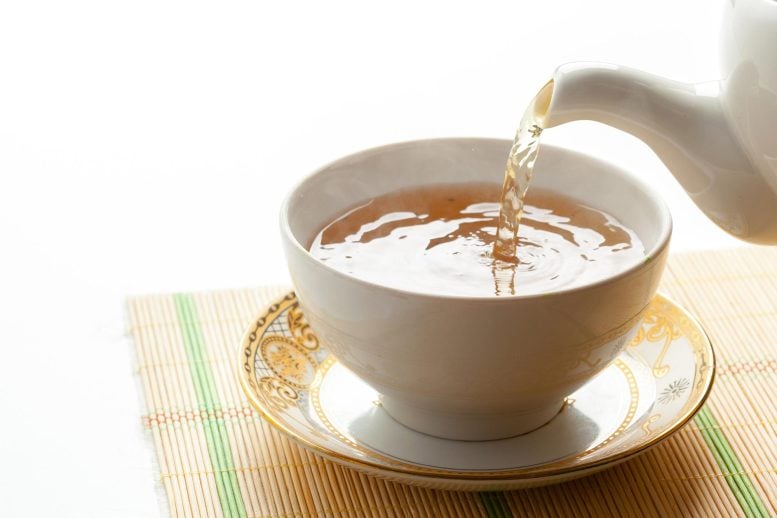
Researchers from the Nagoya Institute of Technology have discovered that the glazing on ceramic tea sets significantly influences the preservation of catechin flavonoids in tea.
Glazes on tea sets significantly reduce the amount of catechins, altering the flavor, aroma, and health benefits of tea.
Introduced as a medicinal drink around 2700 B.C., tea has grown to be the one of the most popular beverages worldwide. One of the key reasons for its popularity is its rich content of flavonoids and polyphenols, which contribute to the antioxidant property, flavor, and aroma of tea, offering various potential health benefits. These compounds are extracted from tea leaves during brewing and can be influenced by several factors, such as water temperature, brewing time, and the materials used in tea preparation vessels.
Recent Research Findings
Recently, researchers from Nagoya Institute of Technology (NITech) in Japan have revealed, for the first time, that the choice of glazing on ceramic tea sets used to prepare tea plays a key role in the retention of catechin flavonoids. In their study published recently in the journal Scientific Reports, Associate Professor Takashi Shirai, along with Dr. Yunzi Xin, Mr. Sota Shido, and Dr. Kunihiko Kato from the Advanced Ceramics Research Center at NITech, examined the impact of four different typical Japanese commercial glazes–Oribe, Namako, Irabo, and Toumei–on the content of catechins, the most abundant flavonoid found in green tea.
Glazes on tea sets significantly reduce the amount of catechins in tea by oxidizing them, altering the flavor, aroma, and health benefits of tea. Credit: Dr. Takashi Shirai from NITech, Japan
Properties and Composition of Glazes
While glaze coatings primarily consist of feldspar minerals, such as silicon, aluminum, sodium, and calcium oxides, they also contain distinct metal oxide species that impart a unique appearance and texture to the ceramic vessel. Oribe glaze predominantly contains copper (Cu) oxides and imparts a vibrant green color, while Namako glaze contains cobalt (Co) oxides for a dark blue appearance. Irabo glaze contains iron (Fe) oxides that impart orange tones, while Toumei glaze has a high titanium (Ti) content, providing a transparent finish.
Methodology and Observations
To examine the effect of the glaze on tea catechins, the researchers brewed a green tea solution using ion-exchanged water at 80°C (176°F) for three minutes. The tea leaves were separated, and the supernatant (liquid lying above solid residue) was mixed with glaze powders coated on ceramic tiles. The glaze-tea mixture was then allowed to react for six hours, followed by the removal of the glaze powder through centrifugation and filtration.
The researchers observed that the pristine tea solution had a clear bright yellow color, but after six hours of degradation, it turned into a yellowish-brown color. In contrast, the tea solutions degraded by different glazes exhibited darker black or brown colors. In other words, the extent of color change depended significantly on the type of glaze.

Sample pieces of glaze-coated tile (b) tea solutions before and after mixing with glazes (top) and degraded tea solutions with and without existence of glazes (bottom). Credit: Takashi Shirai from NITech, Japan
Moreover, a selective reduction in the amount of altered catechins in tea was also observed by the researchers. The tea solutions mixed with Oribe, Namako, and Irabo glazes showed significantly lower concentrations of epicatechin, epicatechin gallate, epigallocatechin, and epigallocatechin gallate, while the Toumei glaze selectively degraded epigallocatechin gallate. The reduction in catechin concentration and the resulting color change can be attributed to the oxidation process of catechins, which forms brownish thearubigins and reddish-orange theaflavin and its oxide pigments.
Scientific Explanation and Implications
“During the degradation process, Cu-, Co-, Fe-, and Ti-oxides in glaze powders can act as a Lewis acid catalyst and promote the oxidation of catechin molecules to ortho-quinones, followed by further reaction to form thearubigins and/or theaflavin and its oxides. Another oxidation route is through the polymerization of intermediate free radical catechins,” explains Dr. Shirai. “And it is very interesting that thearubigins and theaflavins are the main components of fermented tea like black tea. In other words, green tea brewed by specific ceramic tea sets can be turned into black tea.”
In summary, this study highlights that the choice of glaze materials used in ceramic tea sets can significantly affect the concentration of beneficial compounds such as catechins in tea. “The specific function of glazes on the degradation of catechins not only provides principal information for the design and development of functional materials but can also impact daily tea drinking and long-term human health-related issues,” concludes Dr. Shirai.
Reference: “Glazes induced degradation of tea catechins” by Yunzi Xin, Sota Shido, Kunihiko Kato and Takashi Shirai, 28 June 2023, Scientific Reports.
DOI: 10.1038/s41598-023-37480-8
The authors acknowledge Mizuno Kagaku Kogyo Co., Ltd for providing the glaze products.









The glaze on tea sets is normally fired as part of the pottery. These tests sound like raw glaze materials were mixed into the tea???
The glazes were fired, and then pulverized, then added to the tea.
I still question the testing procedures. Yes glazes contain different types of minerals. High fired glaze compaounds becomes glass on the exterior of the glazed vessel surface. If a vessel is damaged and the glaze has chipped off then YES the tea is being exposed to the fired glaze elements. Grinding up fired glazes would have to include some portion of clay body that held the liquid glaze. Going to read the entire study report. Many questions from this redacted reort.
Indeed! Who is going to rewarm their tea and drink it 6 hours after initially brewing it? It sounds like an academic solution in search of a problem.
still dont know it that is good or bad